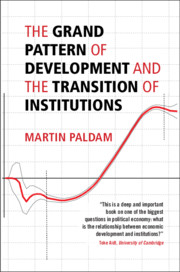Book contents
- The Grand Pattern of Development and the Transition of Institutions
- The Grand Pattern of Development and the Transition of Institutions
- Copyright page
- Contents
- Figures
- Tables
- Preface
- Part I Main Ideas
- Part II The Transitions of Institutions
- Contents
- Part IIA The Democratic Transition
- Contents
- 4 Literature, Data, Transition Path, and Causality
- 5 The Jumps Model for the Short Run
- 6 Events Are Practically Random
- 7 The Three Pillars Model for the Long Run
- Part IIB The Transition of the Economic System
- Part IIC The Transitions in Traditions and Beliefs
- Part III The Grand Transition
- References
- Index
4 - Literature, Data, Transition Path, and Causality
from Part IIA - The Democratic Transition
Published online by Cambridge University Press: 07 August 2021
- The Grand Pattern of Development and the Transition of Institutions
- The Grand Pattern of Development and the Transition of Institutions
- Copyright page
- Contents
- Figures
- Tables
- Preface
- Part I Main Ideas
- Part II The Transitions of Institutions
- Contents
- Part IIA The Democratic Transition
- Contents
- 4 Literature, Data, Transition Path, and Causality
- 5 The Jumps Model for the Short Run
- 6 Events Are Practically Random
- 7 The Three Pillars Model for the Long Run
- Part IIB The Transition of the Economic System
- Part IIC The Transitions in Traditions and Beliefs
- Part III The Grand Transition
- References
- Index
Summary
The chapter develops the stylized facts used in the following three chapters and surveys the literature on the effect of development on democracy and on the effect of democracy on development. The main dataset is the Polity P-index with 7,142 annual observations covering 1960–2016 in the Main sample and 818 in the OPEC sample. The chapter also considers the two political indices from Freedom House. The transition curves for the three political indices are beautiful. The transition curves are robust, with the OPEC-exception. The variability of the political system vanishes with development in accordance with the End of History hypothesis. The causality tests show that increased income causes democracy with little simultaneity only. This finding is robust over 200 years.
- Type
- Chapter
- Information
- Publisher: Cambridge University PressPrint publication year: 2021

